The Impact of Using Co-Compost on Resource Management and Resilience of Smallholder Agriculture in South India
Abstract
1. Introduction
1.1. Problem Status
1.2. Relevance
1.3. Research Gap
1.4. Objective
2. Materials and Methods
2.1. Co-Compost
2.2. Background of The Investigation Area
2.3. Methodology
3. Results
3.1. Challenges
3.2. Resource Management
3.3. Motivation
4. Discussion
4.1. Alternative Circular Co-Concepts
4.2. Co-Compost for Agriculture
4.3. Attitude of Farmers
4.4. Communication Aspects
4.5. Approach of the Methodology
5. Conclusions
Author Contributions
Funding
Data Availability Statement
Acknowledgments
Conflicts of Interest
References
- Fiksel, J.; Sanjay, P.; Raman, K. Steps toward a resilient circular economy in India. Clean Technol. Environ. Policy 2020, 23, 1–16. [Google Scholar] [CrossRef] [PubMed]
- FAO. India at a Glace. Available online: https://www.fao.org/india/fao-in-india/india-at-a-glance/en/ (accessed on 9 December 2021).
- Graeub, B.E.; Chappell, M.J.; Wittman, H.; Ledermann, S.; Kerr, R.B.; Gemmill-Herren, B. The State of Family Farms in the World. World Dev. 2016, 87, 1–15. [Google Scholar] [CrossRef]
- Borrelli, P.; Robinson, D.A.; Fleischer, L.R.; Lugato, E.; Ballabio, C.; Alewell, C.; Meusburger, K.; Modugno, S.; Schütt, B.; Ferro, V.; et al. An assessment of the global impact of 21st century land use change on soil erosion. Nat. Commun. 2017, 8, 2013. [Google Scholar] [CrossRef]
- Ahmed, M.; Sarma, P. Exploring the Opportunities and Constraints of Rural Livelihood: A Case Study of Small Farmers Engaged in Rice Cultivation in India. Alex. Sci. Exch. J. 2021, 42, 523–537. [Google Scholar] [CrossRef]
- Bisht, I.S.; Rana, J.C.; Pal Ahlawat, S. The Future of Smallholder Farming in India: Some Sustainability Considerations. Sustainability 2020, 12, 3751. [Google Scholar] [CrossRef]
- Sravanth, K.R.S.; Sundaram, N. Agricultural Crisis and Farmers Suicides in India. IJITEE 2019, 8, 1576–1580. [Google Scholar] [CrossRef]
- Aryal, J.P.; Sapkota, T.B.; Khurana, R.; Khatri-Chhetri, A.; Rahut, D.B.; Jat, M.L. Climate change and agriculture in South Asia: Adaptation options in smallholder production systems. Environ. Dev. Sustain. 2020, 22, 5045–5075. [Google Scholar] [CrossRef]
- Datta, P.; Behera, B. What caused smallholders to change farming practices in the era of climate change? Empirical evidence from Sub-Himalayan West Bengal, India. GeoJournal 2021, 1–17. [Google Scholar] [CrossRef]
- Lansche, J.; Awiszus, S.; Latif, S.; Müller, J. Potential of Biogas Production from Processing Residues to Reduce Environmental Impacts from Cassava Starch and Crisp Production—A Case Study from Malaysia. Appl. Sci. 2020, 10, 2975. [Google Scholar] [CrossRef]
- Minale, M.; Worku, T. Anaerobic co-digestion of sanitary wastewater and kitchen solid waste for biogas and fertilizer production under ambient temperature: Waste generated from condominium house. Int. J. Environ. Sci. Technol. 2014, 11, 509–516. [Google Scholar] [CrossRef]
- Lin, W.; Lin, M.; Zhou, H.; Wu, H.; Li, Z.; Lin, W. The effects of chemical and organic fertilizer usage on rhizosphere soil in tea orchards. PLoS ONE 2019, 14, e0217018. [Google Scholar] [CrossRef]
- Savci, S. Investigation of Effect of Chemical Fertilizers on Environment. APCBEE Procedia 2012, 1, 287–292. [Google Scholar] [CrossRef]
- Nicolopoulou-Stamati, P.; Maipas, S.; Kotampasi, C.; Stamatis, P.; Hens, L. Chemical Pesticides and Human Health: The Urgent Need for a New Concept in Agriculture. Front. Public Health 2016, 4, 148. [Google Scholar] [CrossRef]
- Sharma, N.; Singhvi, R. Effects of Chemical Fertilizers and Pesticides on Human Health and Environment: A Review. Intern. J. Agricul. Environ. Biotech. 2017, 10, 675. [Google Scholar] [CrossRef]
- Patra, S.; Mishra, P.; Mahapatra, S.C.; Mithun, S.K. Modelling impacts of chemical fertilizer on agricultural production: A case study on Hooghly district, West Bengal, India. Model. Earth Syst. Environ. 2016, 2, 1–11. [Google Scholar] [CrossRef]
- Mihelcic, J.R.; Fry, L.M.; Shaw, R. Global potential of phosphorus recovery from human urine and feces. Chemosphere 2011, 84, 832–839. [Google Scholar] [CrossRef] [PubMed]
- Moomaw, W.; Barthel, M. The Critical Role of Global Food Consumption Patterns in Achieving Sustainable Food Systems and Food for All. A UNEP Discussion Paper; United Nations Environment Programme: Nairobi, Kenya, 2012. [Google Scholar]
- Kumar, S.; Smith, S.R.; Fowler, G.; Velis, C.; Kumar, S.J.; Arya, S.; Rena; Kumar, R.; Cheeseman, C. Challenges and opportunities associated with waste management in India. R. Soc. Open Sci. 2017, 4, 160764. [Google Scholar] [CrossRef] [PubMed]
- Gill, K.; Verma, I. Circular Economy: A Review of Global Practices and Initiatives with Special Reference to India. Focus 2021, 8, 187–205. [Google Scholar] [CrossRef]
- Sugihara, R. Reuse of Human Excreta in Developing Countries. Consilience 2020, 22, 58–64. [Google Scholar]
- Speier, C.J.; Mondal, M.M.; Weichgrebe, D. Evaluation of compositional characteristics of organic waste shares in municipal solid waste in fast-growing metropolitan cities of India. J. Mater. Cycles Waste Manag. 2018, 20, 2150–2162. [Google Scholar] [CrossRef]
- Hettiarachchi, H.; Caucci, S.; Schwärzel, K. Organic Waste Composting through Nexus Thinking; Springer International Publishing: Cham, Switzerland, 2020; ISBN 978-3-030-36282-9. [Google Scholar]
- Masullo, A. Organic wastes management in a circular economy approach: Rebuilding the link between urban and rural areas. Ecol. Eng. 2017, 101, 84–90. [Google Scholar] [CrossRef]
- Fendel, V.; Kranert, M.; Maurer, C.; Garcés-Sánchez, G.; Huang, J.; Ramakrishna, G. Stakeholder Assessment on Closing Nutrient Cycles through Co-Recycling of Biodegradable Household Kitchen Waste and Black Water between Rural and Urban Areas in South India. Recycling 2022, 7, 49. [Google Scholar] [CrossRef]
- Schroeder, P.; Anggraeni, K.; Weber, U. The Relevance of Circular Economy Practices to the Sustainable Development Goals. J. Ind. Ecol. 2019, 23, 77–95. [Google Scholar] [CrossRef]
- United Nations. Transforming Our World: The 2030 Agenda for Sustainable Development. Available online: https://sustainabledevelopment.un.org/post2015/transformingourworld/publication (accessed on 21 April 2022).
- Fendel, V.; Maurer, C.; Kranert, M.; Huang, J.; Schäffner, B. The Potential of the Co-Recycling of Secondary Biodegradable Household Resources Including Wild Plants to Close Nutrient and Carbon Cycles in Agriculture in Germany. Sustainability 2022, 14, 5277. [Google Scholar] [CrossRef]
- Müller, S.; Backhaus, N.; Nagabovanalli, P.; Abiven, S. A social-ecological system evaluation to implement sustainably a biochar system in South India. Agron. Sustain. Dev. 2019, 39, 1–4. [Google Scholar] [CrossRef]
- Patwa, N.; Sivarajah, U.; Seetharaman, A.; Sarkar, S.; Maiti, K.; Hingorani, K. Towards a circular economy: An emerging economies context. J. Bus. Res. 2021, 122, 725–735. [Google Scholar] [CrossRef]
- Girija, R.; Shettigar, N.A.; Parama, V.R.R.; Gagana, S. Evaluation of Co-Composted Faecal Sludge Application in Agriculture. In Proceedings of the The Sustainable City XIII. Sustainable City 2019, Valencia, Spain, 1–3 October 2019; Mambretti, S., Miralles i Garcia, J.L., Eds.; WIT Press: Southampton, UK, 2019; pp. 701–711. [Google Scholar]
- Torgbo, S.; Quaye, E.A.; Adongo, T.A.; Opoku, N. The effects of dried faecal sludge and municipal waste co-compost on microbial load and yield of cabbage (Brassica oleracea L. Var. capitata) and lettuce (Lactuca sativa). J. Microbiol. Biotechnol. Food Sci. 2021, 7, 555–561. [Google Scholar] [CrossRef]
- Mallory, A.; Akrofi, D.; Dizon, J.; Mohanty, S.; Parker, A.; Rey Vicario, D.; Prasad, S.; Welivita, I.; Brewer, T.; Mekala, S.; et al. Evaluating the circular economy for sanitation: Findings from a multi-case approach. Sci. Total Environ. 2020, 744, 140871. [Google Scholar] [CrossRef]
- Singh, S.; Ibrahim, M.A.; Pawar, S.; Brdjanovic, D. Public Perceptions of Reuse of Faecal Sludge Co-Compost in Bhubaneswar, India. Sustainability 2022, 14, 4489. [Google Scholar] [CrossRef]
- Gwara, S.; Wale, E.; Odindo, A.; Buckley, C. Attitudes and Perceptions on the Agricultural Use of Human Excreta and Human Excreta Derived Materials: A Scoping Review. Agriculture 2021, 11, 153. [Google Scholar] [CrossRef]
- Consortium for DEWATS Dissemination (CDD) Society, Bengaluru. Insights from Faecal Sludge Management in Devanahalli: Five Years of Operations. Available online: https://cddindia.org/wp-content/uploads/Insights-from-Devanahalli-December-2020.pdf (accessed on 8 August 2022).
- Rural Development Organisation (RDO) Trust. Faecal Sludge Treatment plants in Ketty and Adhigaratty panchayats in Nilgiris District. Available online: https://rdotrust.org/?page_id=495 (accessed on 8 August 2022).
- Farsi, A. Migranten auf dem Weg zur Elite? Springer Fachmedien Wiesbaden: Wiesbaden, Germany, 2014; ISBN 978-3-658-01563-3. [Google Scholar]
- Raithel, J. Quantitative Forschung: Ein Praxiskurs; Springer: Berlin/Heidelberg, Germany, 2006; ISBN 3531161814. [Google Scholar]
- Ritchie, J.; Lewis, J.; McNauthon Nicholls, C.; Ormston, R. Qualitative Research Practice: A Guide for Social Science Students and Researchers; NatCen Social Research: London, UK, 2003. [Google Scholar]
- Porst, R. Fragebogen: Ein Arbeitsbuch; Springer: Berlin/Heidelberg, Germany, 2013; ISBN 978-3-658-02117-7. [Google Scholar]
- Krause, A.; Rotter, V. Recycling Improves Soil Fertility Management in Smallholdings in Tanzania. Agriculture 2018, 8, 31. [Google Scholar] [CrossRef]
- Remy, C.; Ruhland, A. Ecological Assessment of Alternative Sanitation Concepts with Life Cycle Assessment: Final Report for Subtask 5 of the Demonstration Project “Sanitation Concepts for Separate Treatment of Urine, Faeces and Greywater“ (SCST); Technical University Berlin: Berlin, Germany, 2006; Volume 55. [Google Scholar]
- Friedrich, J.; Poganietz, W.-R.; Lehn, H. Life-cycle assessment of system alternatives for the Water-Energy-Waste Nexus in the urban building stock. Resour. Conserv. Recycl. 2020, 158, 104808. [Google Scholar] [CrossRef]
- Sabki, M.H.; Lee, C.T.; Bong, C.P.C.; Klemens, J.J. A review on the economic feasibility of composting for organic waste management in Asian countries. Chem. Eng. Trans. 2018, 70, 49–54. [Google Scholar]
- Ezeudu, O.B.; Ezeudu, T.S.; Ugochukwu, U.C.; Agunwamba, J.C.; Oraelosi, T.C. Enablers and barriers to implementation of circular economy in solid waste valorization: The case of urban markets in Anambra, Southeast Nigeria. Environ. Sustain. Indic. 2021, 12, 100150. [Google Scholar] [CrossRef]
- Carr, G.; Potter, R.B.; Nortcliff, S. Water reuse for irrigation in Jordan: Perceptions of water quality among farmers. Agric. Water Manag. 2011, 98, 847–854. [Google Scholar] [CrossRef]
- Köck-Schulmeyer, M.; Ginebreda, A.; Postigo, C.; Lopez-Serna, R.; Perez, S.; Brix, R.; Llorca, M.; López de Alda, M.; Petrović, M.; Munne, A.; et al. Wastewater reuse in Mediterranean semi-arid areas: The impact of discharges of tertiary treated sewage on the load of polar micro pollutants in the Llobregat river (NE Spain). Chemosphere 2011, 82, 670–678. [Google Scholar] [CrossRef]
- Ceballos, F.; Kannan, S.; Kramer, B. Impacts of a national lockdown on smallholder farmers’ income and food security: Empirical evidence from two states in India. World Dev. 2020, 136, 105069. [Google Scholar] [CrossRef]
- Gwara, S.; Wale, E.; Odindo, A. Behavioral intentions of rural farmers to recycle human excreta in agriculture. Sci. Rep. 2022, 12, 5890. [Google Scholar] [CrossRef]
- Roxburgh, H.; Hampshire, K.; Tilley, E.A.; Oliver, D.M.; Quilliam, R.S. Being shown samples of composted, granulated faecal sludge strongly influences acceptability of its use in peri-urban subsistence agriculture. Resour. Conserv. Recycl. X 2020, 7, 100041. [Google Scholar] [CrossRef]
- Chaudhuri, S.; Roy, M.; McDonald, L.M.; Emendack, Y. Reflections on farmers’ social networks: A means for sustainable agricultural development? Environ. Dev. Sustain. 2021, 23, 2973–3008. [Google Scholar] [CrossRef]
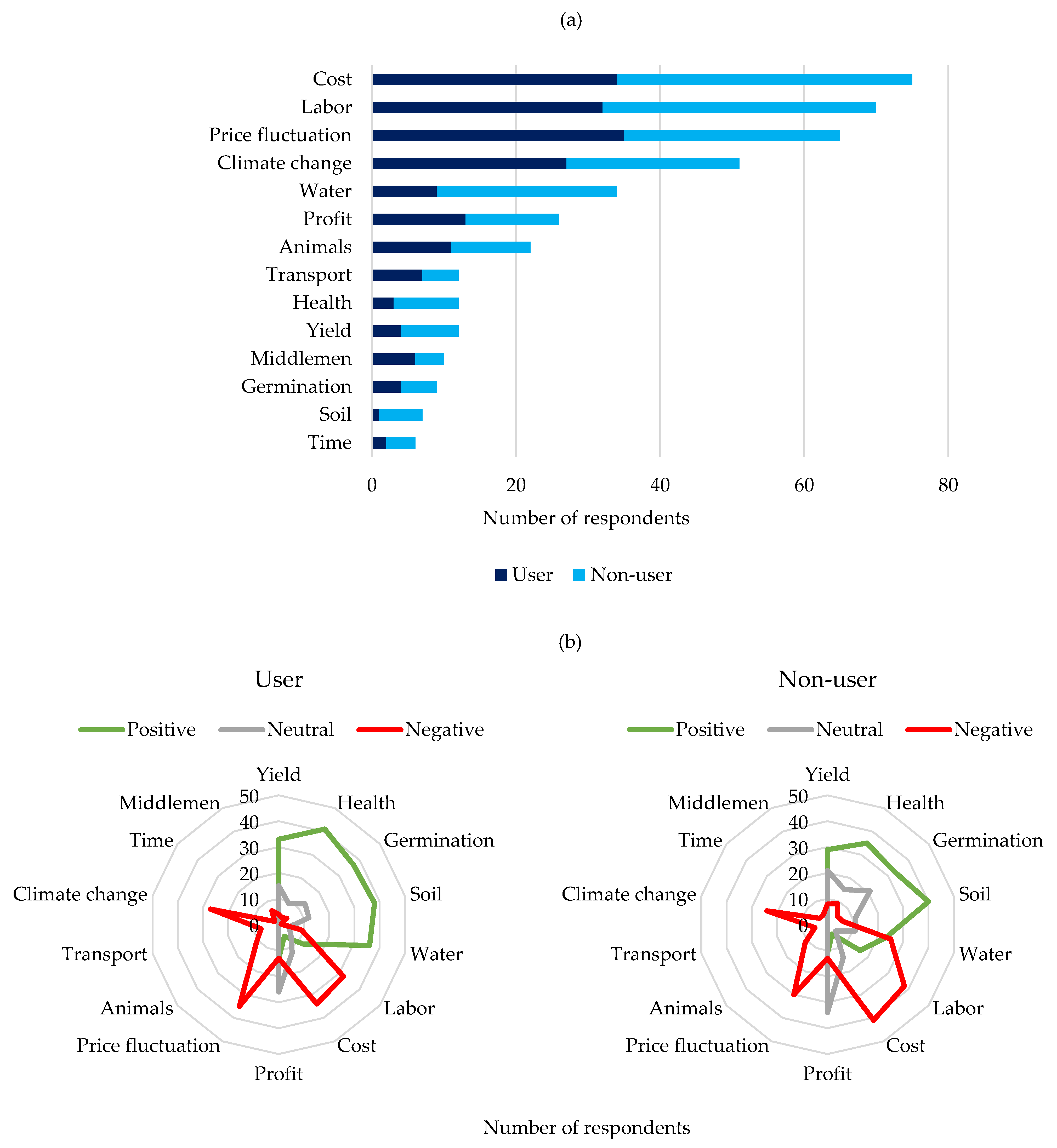
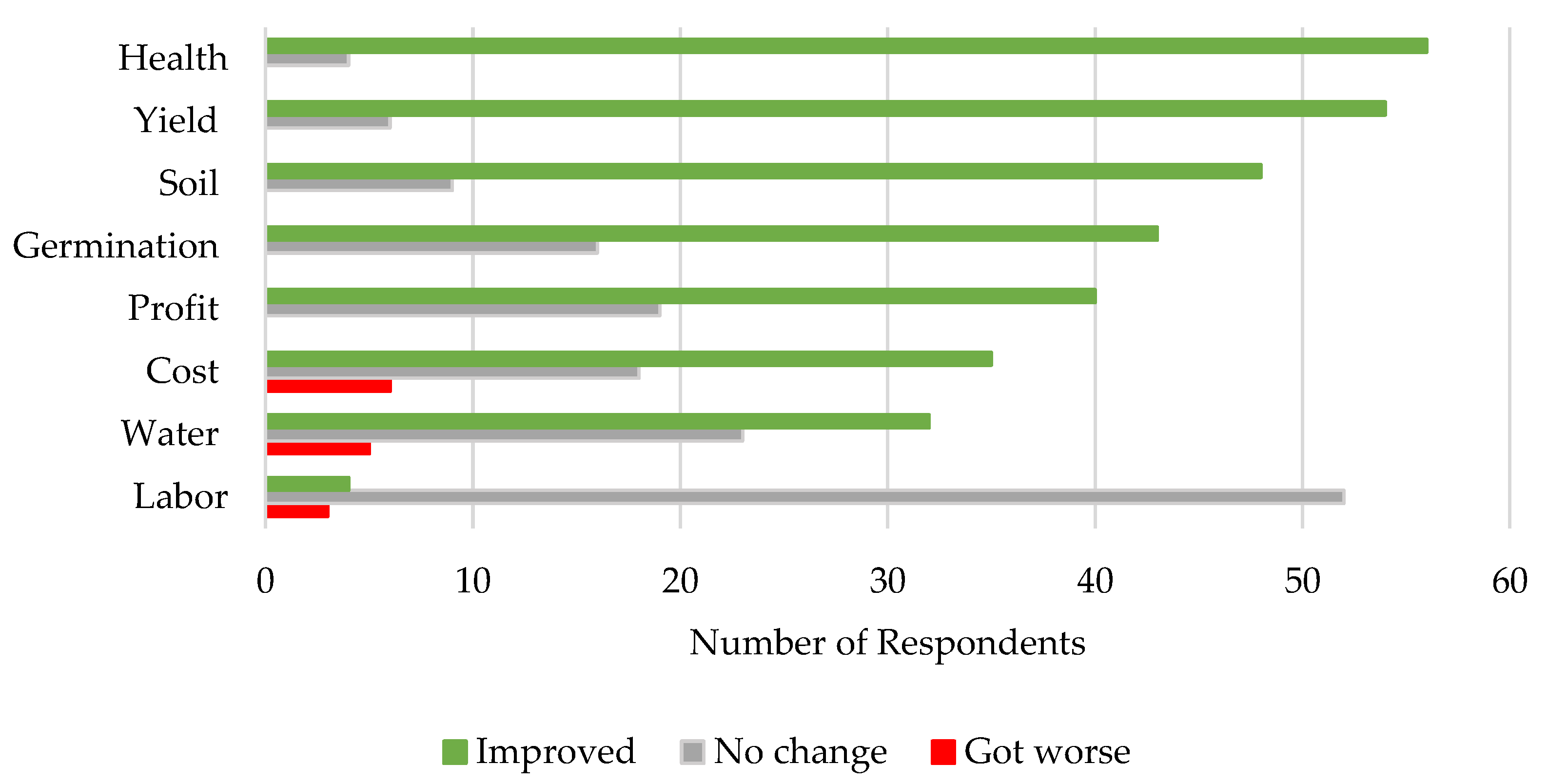
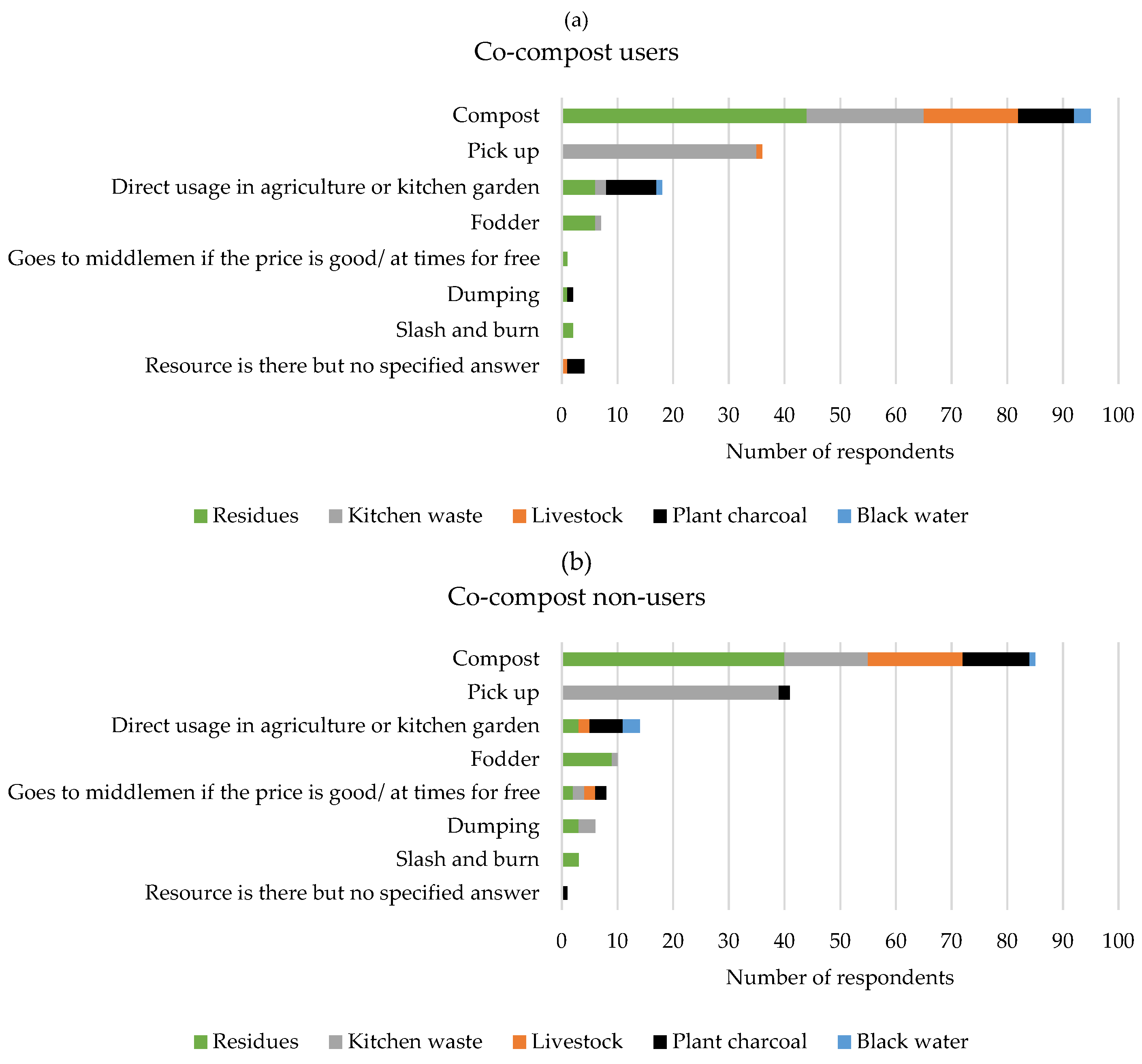
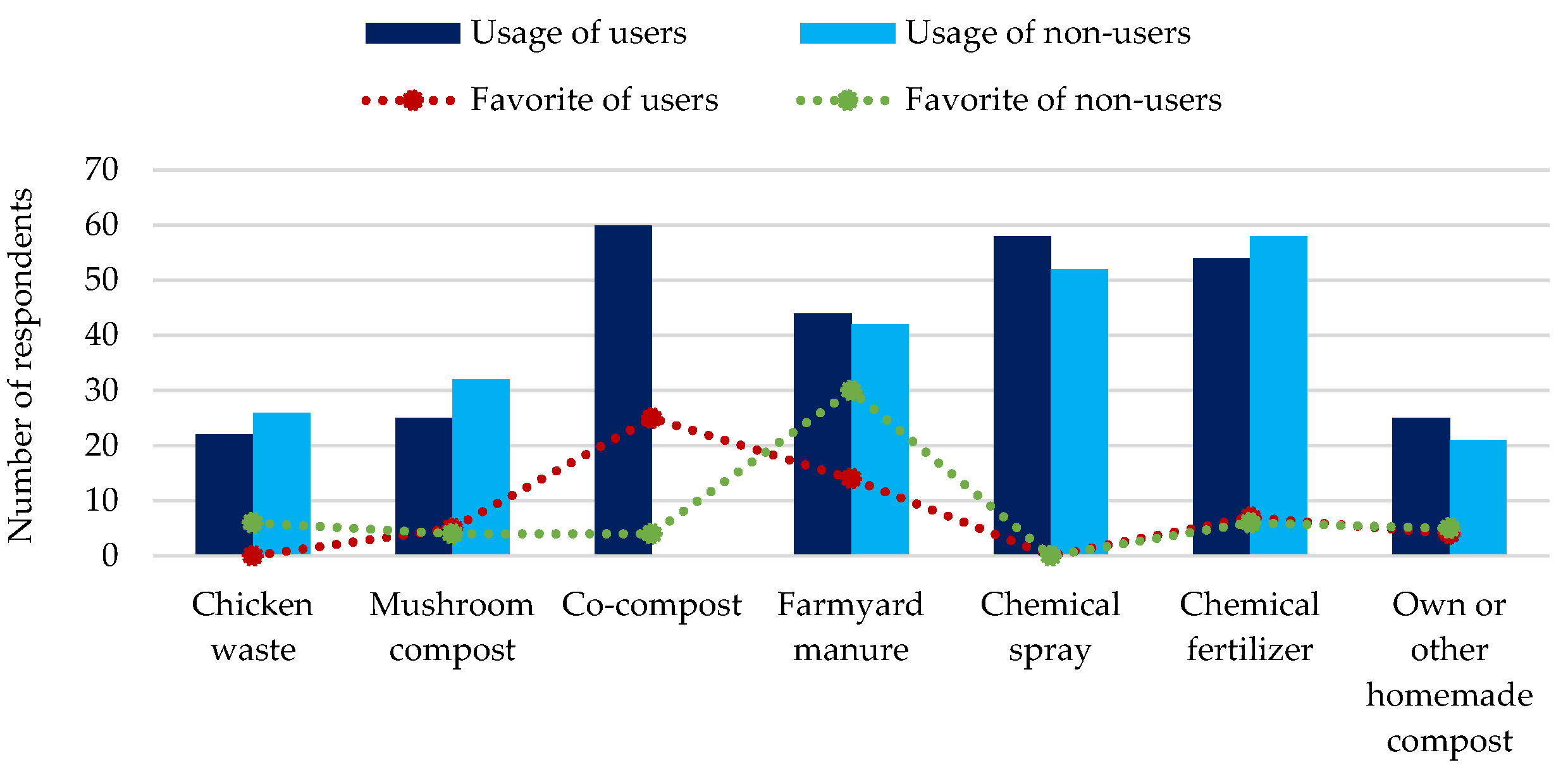

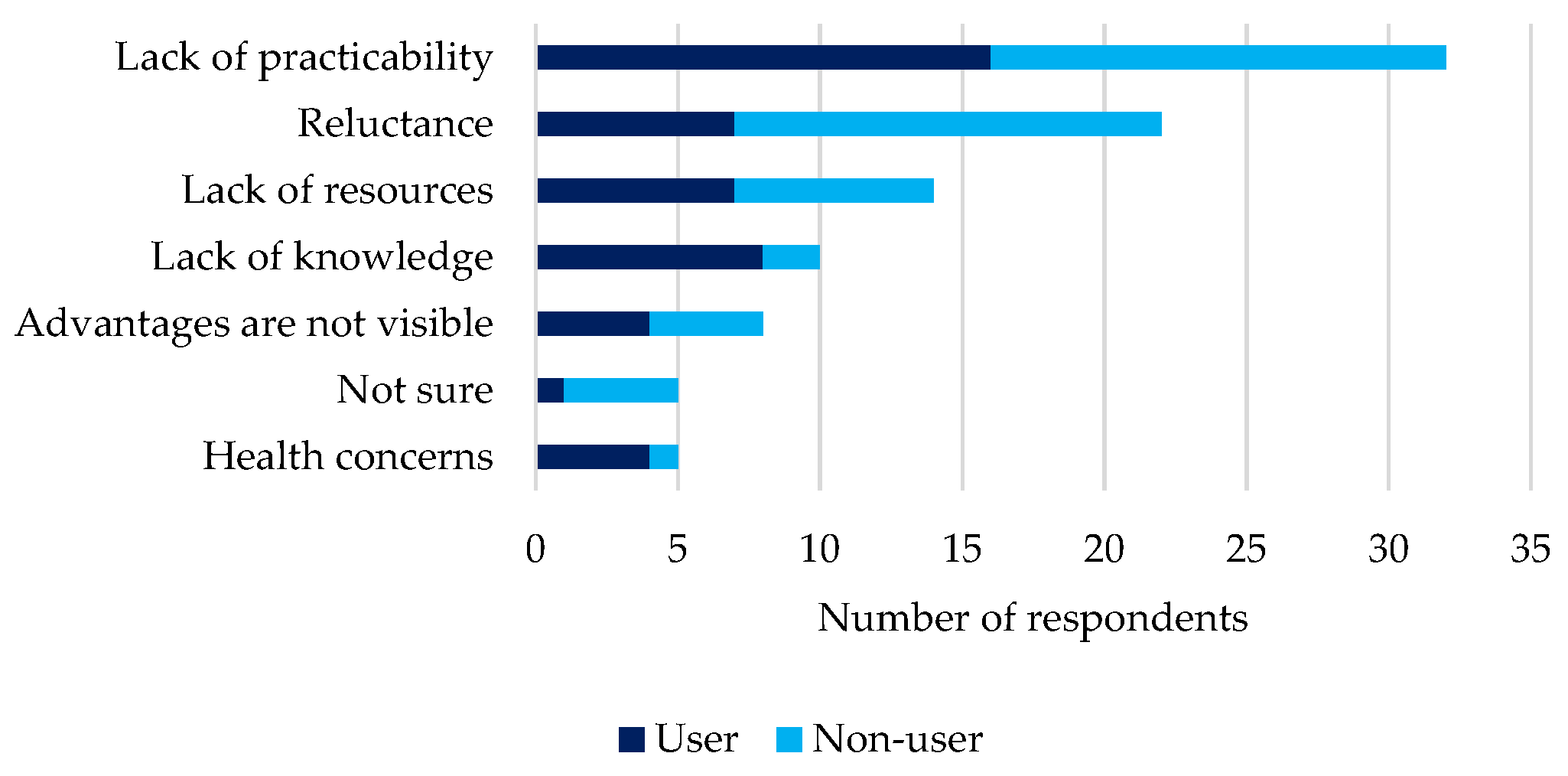
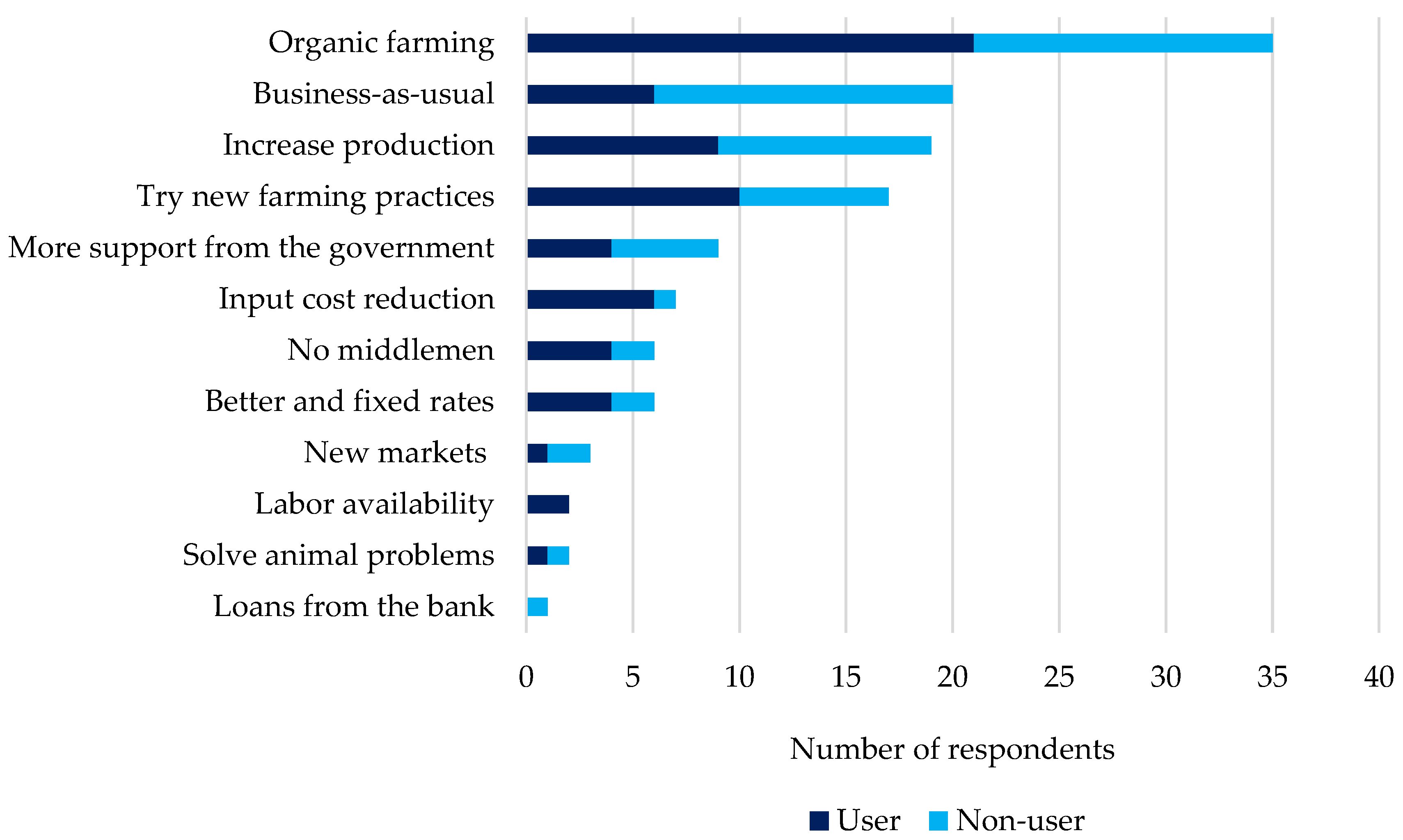
| Indicator | N | Unit | User 1 | Non-User 1 |
|---|---|---|---|---|
| Place | ||||
| ● Nilgiris | 100 | % | 83 | 83 |
| ● Devanahalli | 20 | % | 17 | 17 |
| Age | 120 | Years (average) 2 | 47 ± 12 | 46 ± 13 |
| Gender | ||||
| ● Female | 19 | % | 15 | 17 |
| ● Male | 101 | % | 85 | 83 |
| Land size | 120 | Acres (average) 2 | 2.13 ± 2.04 | 2.18 ± 2.74 |
| Property | ||||
| ● Own | 74 | Valid % | 63 | 62 |
| ● Rented | 36 | Valid % | 27 | 33 |
| ● Both | 9 | Valid % | 10 | 5 |
| ● No indication | 1 | Frequency | 1 | 0 |
| Irrigation system | ||||
| ● Sprinkler/butterfly | 85 | Valid % | 78 | 75 |
| ● Manual | 14 | Valid % | 15 | 11 |
| ● Drip irrigation | 12 | Valid % | 7 | 14 |
| ● No indication | 1 | Frequency | 5 | 4 |
| Water source | ||||
| ● Own well/pond | 52 | Valid % | 52 | 50 |
| ● River/stream | 29 | Valid % | 26 | 31 |
| ● Shared/public well/pond | 17 | Valid % | 18 | 15 |
| ● Other | 4 | Valid % | 4 | 4 |
| ● No indication | 1 | Frequency | 10 | 8 |
| Annual income 3 | ||||
| ● <910 $ | 42 | Valid % | 39 | 32 |
| ● 910–1560$ | 31 | Valid % | 29 | 24 |
| ● >1560 $ | 45 | Valid % | 32 | 44 |
| ● No indication | 2 | Frequency | 1 | 1 |
| Distance to the closest market | 120 | km (average) 2 | 41.88 ± 15.98 | 42.34 ± 14.9 |
| Usage of middlemen | ||||
| ● Yes | 41 | Valid % | 39 | 34 |
| ● No | 54 | Valid % | 43 | 54 |
| ● Both | 17 | Valid % | 18 | 13 |
| ● No indication | 8 | Frequency | 4 | 4 |
| Co-compost (average numbers)2 | ||||
| ● Years of usage | 120 | Years (average) 2 | 1.94 ± 1.09 | 0.00 |
| ● Price 3 | 120 | $/kg (average) 2 | 0.07 ± 0.007 | 0.07 ± 0.008 |
| ● Distance for pick up | 120 | km (average) 2 | 5.84 ± 5.91 | 4.94 ± 5.05 |
| Indicator | N (User) | N (Non-User) | Unit 1 | User | Non-User | Eta-Coefficient |
|---|---|---|---|---|---|---|
| Carrots | 48 | 52 | t/acre | 13.52 ± 7.76 | 11.41 ± 6.27 | 0.150 |
| Potato | 31 | 39 | t/acre | 9.15 ± 6.10 | 7.17 ± 4.10 | 0.193 |
| Beetroot | 27 | 30 | t/acre | 11.76 ± 8.14 | 9.64 ± 7.48 | 0.137 |
| Garlic | 22 | 22 | t/acre | 6.15 ± 3.68 | 6.42 ± 3.88 | 0.037 |
| Unit | User | Non-User | Eta-Coefficient | |||||
|---|---|---|---|---|---|---|---|---|
| N | Mean | SD | N | Mean | SD | |||
| Own compost | t (acre ∙season)−1 | 11 | 2.24 | 3.86 | 8 | 2.28 | 4.17 | 0.016 |
| Co-compost | t (acre ∙season)−1 | 43 | 3.3 | 6.7 | ||||
| Mushroom waste | t (acre ∙season)−1 | 22 | 9.22 | 10.36 | 30 | 13.08 | 16.63 | 0.134 |
| Farmyard manure | t (acre ∙season)−1 | 34 | 13.82 | 16.8 | 36 | 12.51 | 11.61 | 0.046 |
| Chicken waste | t (acre ∙season)−1 | 18 | 8.66 | 11.19 | 20 | 12.66 | 13.37 | 0.163 |
| Plant charcoal | kg (month)−1 | 17 | 26.53 | 24.76 | 18 | 18.54 | 24.28 | 0.165 |
| Chemical fertilizer | ||||||||
| ● Before co-compost usage | t (acre ∙year)−1 | 46 | 1.42 | 2.1 | 53 | 1.57 | 5.42 | 0.019 |
| ● After co-compost usage | t (acre ∙year)−1 | 35 | 0.9 | 1.35 | ||||
| ● % reduction 1 | % | 33 | 44.21 | 15.91 | ||||
| Chemical spray | ||||||||
| ● Before co-compost usage | L (acre ∙year)−1 | 26 | 8.16 | 12.88 | 29 | 8.35 | 13.62 | 0.007 |
| ● After co-compost usage | t (acre ∙year)−1 | 4 | 6.63 | 9.03 | ||||
| ● % reduction 1 | % | 11 | 35.45 | 21.27 | ||||
| Water usage reduction in dry season 1 | % | 22 | 30.3 | 19.92 | ||||
Publisher’s Note: MDPI stays neutral with regard to jurisdictional claims in published maps and institutional affiliations. |
© 2022 by the authors. Licensee MDPI, Basel, Switzerland. This article is an open access article distributed under the terms and conditions of the Creative Commons Attribution (CC BY) license (https://creativecommons.org/licenses/by/4.0/).
Share and Cite
Fendel, V.; Kranert, M.; Maurer, C.; Garcés-Sánchez, G.; Huang, J.; Ramakrishna, G. The Impact of Using Co-Compost on Resource Management and Resilience of Smallholder Agriculture in South India. Environments 2022, 9, 143. https://doi.org/10.3390/environments9110143
Fendel V, Kranert M, Maurer C, Garcés-Sánchez G, Huang J, Ramakrishna G. The Impact of Using Co-Compost on Resource Management and Resilience of Smallholder Agriculture in South India. Environments. 2022; 9(11):143. https://doi.org/10.3390/environments9110143
Chicago/Turabian StyleFendel, Veronika, Martin Kranert, Claudia Maurer, Gabriela Garcés-Sánchez, Jingjing Huang, and Girija Ramakrishna. 2022. "The Impact of Using Co-Compost on Resource Management and Resilience of Smallholder Agriculture in South India" Environments 9, no. 11: 143. https://doi.org/10.3390/environments9110143
APA StyleFendel, V., Kranert, M., Maurer, C., Garcés-Sánchez, G., Huang, J., & Ramakrishna, G. (2022). The Impact of Using Co-Compost on Resource Management and Resilience of Smallholder Agriculture in South India. Environments, 9(11), 143. https://doi.org/10.3390/environments9110143







